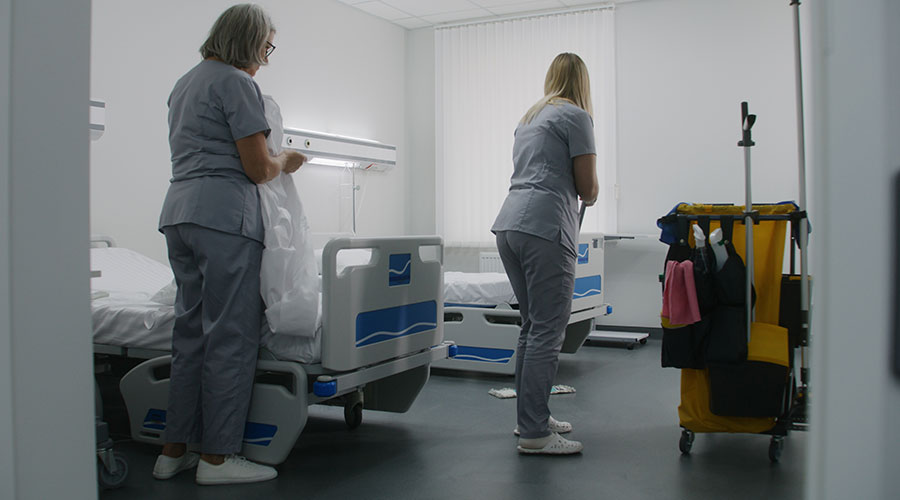When the lights go out, bad things happen. When it comes to hospitals and large healthcare systems, power outages are not an option as patient lives are hanging in the balance. In the recent past, we all watched on TV how devastating healthcare facility outages are in the wake of a major natural disaster like Hurricanes Katrina and Sandy, and as healthcare facility operators we should do our best to make sure they don’t happen again.
While working hard to ensure their facility care is safe for patients and their brand reputation remains intact, healthcare facility managers and healthcare system decision makers also feel tremendous pressure to reduce operating and energy costs. This is one of many reasons hospitals and healthcare systems are seeking new, more centralized solutions for managing individual and multi-site facility infrastructure and operations.
And don’t forget that energy prices are growing while the reliability of the power supply is declining. There are 15 percent more power outages today than there were 10 years ago. Such outages cost the economy more than $125 billion per year — and that is increasing annually.
Adding to the overall annual cost is that the core electrical and mechanical infrastructure within facilities that is aging and therefore requires constant upkeep. According to the Standard and Poor’s Index, the average age of U.S. hospitals is more than 27 years old, and the workforce operating these facilities is getting older too. In fact, according to the Sloan Center on Aging and Work, it is expected that more than 50 percent of facilities management personnel will retire in the next 10 years.
Realities of healthcare consolidation
In addition to general facility challenges, healthcare-specific issues are driving healthcare executives toward a centralized facility management strategy. The healthcare industry is undergoing unprecedented consolidation through mergers and acquisitions (M&A). In this industry alone, there have been more than 550 U.S. hospitals acquired since 2007. In addition, more than 20 percent of today’s independent or smaller hospitals will be acquired within the next five years.
With all of this rampant M&A activity, increasingly larger healthcare systems dominate the landscape in the U.S., as nearly 30 percent of all U.S. hospitals are owned by 44 hospital systems, with an average of almost 40 hospitals per healthcare system. The ability to consolidate and effectively manage numerous facilities within a system has become increasingly difficult, as executives look to streamline facility workforces and work with shrinking budgets. Essentially, do more with less.
Other realities of the business are forcing healthcare executives, facility operators and other decision makers to explore new management solutions for facility infrastructure and operations. For example, within hospitals and the greater healthcare community, accredited bodies – like The Joint Commission (TJC) and Det Norske Veritas (DNV) – have mandated new compliance requirements for healthcare facilities that require closer supervision of electrical system maintenance such as monthly compliance audits that test equipment to help ensure patient safety.
New role for facility operators
Given all the budget pressures, facility managers of today are expected to understand their company’s business and contribute to the bottom line, especially as the healthcare industry undergoes this unprecedented period of consolidation. The days of a facility manager who is responsible for a single facility is over. Not only does the facility manager need to know about maintenance and disaster recovery, they also need to consider reducing facility costs, improving productivity, creating revenue-generating capacity and the brand image of their organization.
Complex, multi-site geographically distributed hospital and healthcare systems are increasingly turning toward corporate centralization of facilities management and operations to address the increasing challenges of operating systems economically, efficiently and reliably. While facility managers can implement certain solutions to improve efficiency of their facilities, too often the time and expertise required to enroll in and implement cost-saving programs — like demand response and other energy-efficiency programs – is in scarce supply among the local facility workforce population. More and more on-site facility managers find themselves overwhelmed by the ever-increasing budget pressures to address the myriad of operating challenges in a quick and effective manner.
So how can complex, multi-site healthcare systems centralize management of their critical facilities to improve energy efficiency and resiliency?
Rise of the energy internet of things
The rise of IP-enabled meters and other power equipment to form “smart grids” has made its way into the healthcare space. The emergence of smart grids and the uptick in M&A activity in the healthcare industry have been major factors in driving demand for centralized facility management (CFM) solutions, because the Internet makes remote management and connectivity cost-effective. The energy world finally has caught up with the Internet of Things (IoT), delivering “Energy IoT” solutions that can connect thousands of power-related devices within critical facilities across broad geographies in a quick and cost-effective manner.
While dealing with a natural disaster like a hurricane is one thing, facilities losing power for mundane reasons like a back-up power generator running out of diesel fuel can be avoided easily but the result can be equally devastating given patients’ lives are on the line.
In an energy IoT-enabled CFM model, a facility operator at a local facility or a remote decision maker sitting at corporate headquarters could monitor fuel levels for multiple back-up generators across multiple sites. Any one of the operators who has access to the centralized dashboard could remotely manage power controls or dispatch technicians before an issue arises with equipment or operational systems. The remote management concept has been around for decades – for example in the telecommunications world where large networks are managed from a network operations center, or NOC; this same concept is coming to smart grid networks in the healthcare industry. It’s that simple.
Implementation path of IoT-Enabled CFM
In most cases the speed of an IoT-enabled CFM migration is predicated upon the number of challenges facing the healthcare system. As we have discussed, the business drivers for CFM are many, including:
● Recent proliferation of hospital acquisitions creating geographically dispersed facilities,
● Aging hospital infrastructure,
● Aging and retiring on-site facility workforce,
● Regulatory and compliance requirements,
● Rising energy costs,
● Brand reputation, and
● Unreliable power supplies.
Most CFM migrations require buy-in from the financial side of the organization. Today, complex healthcare systems already are obtaining the approval of facilities-related capital spending at the corporate level and eliminating this budget decision at local sites. This allows for true system-wide capital prioritization based on critical need.
After the financial decisions have been made, healthcare system operators can begin the provisioning of the Internet-enabled CFM platform that is secure, vendor neutral, and supports highly scalable visualization, power monitoring and control capabilities.
Given the M&A activity happening in the healthcare space, decision makers are seeking power management solutions that are truly vendor neutral. This is critical for large healthcare systems that might include dozens and dozens of sites – which greatly complicates power management as no single facility is the same. Healthcare systems that have grown through M&A can contain hundreds if not thousands of proprietary vendor devices (smart meters, generators, automatic transfer switches, etc), and Internet technology is the fastest, most efficient way to connect these disparate devices.
In addition, by providing a single Internet-enabled equipment connectivity and control platform, healthcare system operators can take a more organized approach to monitoring, maintaining, and testing equipment across multiple sites. For example, facility operators or corporate executives would be able to monitor and test equipment, perform automated remote electronic performance support system (EPSS) testing, and document testing events to meet the requirements of accrediting bodies, like TJC and DNV, while also improving operational health and energy efficiency of their healthcare system.
Finally, once the technical platform for centralization is in place, users can begin employing analytics to centralize operational oversight and management within each facility and across the networked system. Users will be able to implement best practices for capital prioritization to simplify the integration of any newly constructed or acquired facility, centralize reporting and remotely dispatch facility workforces to troubleshoot any issues. What once was done with a truck roll and a clipboard at multiple locations can now be accomplished from a single, remote location or mobile device.
Benefits of IoT-enabled CFM
In addition to monitoring energy performance and efficiency, hospital and healthcare system operators are just beginning to embrace Internet-enabled CFM platforms so they can see how energy resilient their operations are.
Energy resilience is absolutely critical in facilities where bad things happen when the lights go out. CFM systems enabled by energy IoT allow key decision makers to avoid power outages by monitoring their ecosystem of energy IoT devices and systems in a cost-effective manner.
Tom Willie is the CEO of Blue Pillar.

 Disinfectant Dispensers in Healthcare Facilities Often Fail to Deliver Safe Concentrations: Study
Disinfectant Dispensers in Healthcare Facilities Often Fail to Deliver Safe Concentrations: Study Duke University Health System Receives $50 Million for Proton Beam Therapy Center
Duke University Health System Receives $50 Million for Proton Beam Therapy Center UT Southwestern Experiences Data Breach Through Calendar Tool
UT Southwestern Experiences Data Breach Through Calendar Tool Protecting Patient Data: Strategies and Tactics
Protecting Patient Data: Strategies and Tactics Duke Health to Acquire Lake Norman Regional Medical Center
Duke Health to Acquire Lake Norman Regional Medical Center